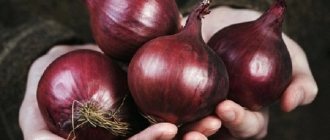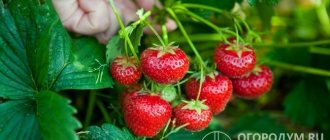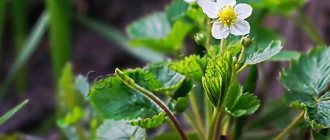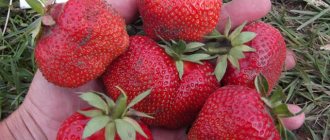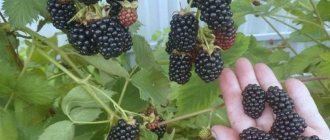Varietal characteristics
Vima Rina is characterized by powerful, well-leafed bushes. The leaf blades are rich green in color, with well-defined ribbing. Petioles of medium length, slightly pubescent. White flowers are collected in spreading inflorescences. The flower stalks are located at the level of the leaves and fall to the ground under the weight of the fruits. The adaptation is below average.
Vima Rina's berries are large, round-conical, elongated, with a well-defined neck. In appearance: deep red color with an attractive glossy surface. The pulp is dense, juicy, delicate consistency. The taste is rich, with a slight sourness. In terms of taste, it is one of the best varieties of the remontant group.
The average fruit weight is about 35-40 g. At the same time, the weight of the first berries can reach up to 70 g or more. When using intensive growing technologies, up to 1 kg can be obtained from one bush per season. fruits In protected soil conditions, productivity indicators almost double. The fruiting period of Vima Rina lasts from the end of June (Central Russia) until the onset of the first frost. The berries do not become smaller by the end of the season.
Landing
Planting Vima Rina strawberries can be done both in spring and autumn. Spring and autumn are good in terms of the availability of seedlings for sale. If we are talking about our own planting material, then the optimal time is the second half of July. Rosettes planted in summer have time to form several horns by autumn, which means the number of flower stalks and next year’s yield will be high.
In case of early spring planting, the first berries can be obtained in the second half of summer.
To plant a strawberry plantation, choose open, well-lit areas with no close groundwater. Clayey, waterlogged and alkaline soils are not suitable for cultivation.
Before planting, the area is cleared of weeds and plowed to a depth of at least 30 cm. At the same time, humus is added at the rate of 1 bucket per m2 and complex mineral fertilizer. Its application rate is indicated directly on the packaging (on average 60-70 g per m2). Mineral fertilizers can be replaced with ash at the rate of a glass of ash per bucket of humus. If more than 1 bucket of humus per m2 is added, then more ash must be added so that there is no strong bias towards nitrogen fertilizers and the bushes do not become fat.
It is most rational to plant strawberries in rows with a distance between plants of 30-35 cm, while for ease of care the row spacing should be at least 50 cm. Before planting, holes are marked in the row, a small amount of humus is poured onto their bottom, which is mixed with the soil.
Before planting, the roots of the seedlings are straightened; they should not bend or extend beyond the planting hole. When planting, the apical bud is located flush with the soil level. The planted bushes are well watered, and the surface of the soil under them is mulched with a layer of peat or straw.
About growing Vim Rin
If you give your strawberry bushes proper care and comfortable living conditions, they will be more tolerant of all possible diseases.
In the greenhouse
If you have a warm greenhouse and comfortable conditions in it, then you can enjoy this berry until the new year. Afterwards you will need to give the bushes a rest for sixty to ninety days. After they have passed, you need to provide proper care and then the berries will appear in mid-spring.
In the greenhouse
If you cultivate this variety under a film cover, like a greenhouse, then you can harvest the crop at the end of the spring period, and it will bear fruit until the very end of the autumn period.
When grown in open areas
When cultivated in open areas, the number of fruits decreases slightly. And the number of harvest waves is reduced by two to three times. You can start collecting from the beginning of summer, before the first frost.
Care
The first time after planting on strawberry bushes, all flower stalks that form are removed. The procedure promotes faster survival.
In the first two weeks after planting, strawberries are watered daily, and the soil is periodically loosened so that a soil crust does not form, which leads to oxygen starvation of the roots.
When caring for strawberries, it is very important to mulch. It helps maintain moisture and inhibits the growth of weeds. It is very convenient to use a special black film or non-woven covering material as mulch. When using it, the share of manual work is reduced several times. However, the high cost of nonwoven materials makes one think about the advisability of using them in the garden of an ordinary gardener. It is easier for the average summer resident to use straw, leaves, and sawdust. The main thing is not to forget that organic mulch binds nitrogen and “gives” it back only when decomposed. To compensate for a temporary lack of nitrogen, it is better to water the mulch with a solution of mullein (1:10) or chicken manure (1:20).
Fertilizer application
One of the most important conditions for obtaining high yields of Vima Rina strawberries is the timely application of fertilizer. Unlike ordinary ones, remontant varieties need more intensive nutrition. They must be constantly provided with nitrogen and potassium.
The next year after planting, at the time the leaves grow, superphosphate and potassium salt are added under the strawberries in a dosage of 20 g per m2. They are scattered between the rows and then buried to a depth of 3-5 cm using a hoe. At the same time, a layer of humus is poured under the bushes at the rate of ½ bucket per m2.
The next feeding is carried out before the start of the second wave of fruiting, which occurs at the end of June. At this point, the plants are fed with a solution of slurry or herbal infusions. To prepare slurry, 2/3 of the barrel is filled with manure. After this, it is topped up with water. After 7-10 days, air bubbles appear on the surface. They indicate the readiness of the fertilizer. Before use, 1 part of the liquid is diluted with 10 parts of water. Remontant strawberries Vima Rina need to be fed until autumn. If this is neglected, the bushes weaken due to intense fruiting and die during the winter.
Starting from the second and third years of cultivation, a slightly different feeding scheme is used. In early spring, nitroammophoska is applied under the plants, followed by embedding, in an amount of 40 g per m2. Liquid organic fertilizers are then used during the growing season.
Plantation update
In the 3rd and subsequent years of cultivation, the berries begin to become very small, and the risk of developing diseases increases, so they try to renew the strawberry plantation every 3 years. To obtain planting material, strong bushes are selected and their flower stalks are removed. This allows you to increase the number of mustaches formed several times. After full development and rooting, they are transplanted to a permanent place. In a year, it will be possible to harvest the first full harvest from this plantation.
The largest number of tendrils is formed by young plants of the first year of life. In subsequent years, the intensity of conformation sharply decreases. It is recommended to renew part of the plantation every year in order to have bushes of different ages and to avoid problems with mustaches.
Agricultural technology
If agricultural technology is strictly followed, then it is possible to prolong the productivity of your berry patch and the fertility of the bushes. Compliance with the rules will result in stable, high yields that will delight you throughout the warm season. Caring for Dutch varieties is not too complicated, and you only need to follow these instructions:
- The best place for growing strawberries is loamy and sandy loam soils with low acidity and moderate alkalinity.
- Strawberries do not tolerate waterlogged or dry areas, so follow the watering rules.
- If the soil is too acidic, then it should be neutralized. To do this, apply liming in this area a year before planting.
- The area allocated for planting strawberries is subjected to deep digging. All lumps are broken, the roots of weeds are removed, which will take away most of the beneficial substances.
- If you plan to plant strawberries in the spring, then the plot should be prepared in the fall. If you intend to plant bushes in the fall, then the site can be prepared two or three weeks before planting.
- In the process of deep digging of soil, it is necessary to fertilize it immediately. This is done by adding for every meter (square) six kilograms of manure or compost (fertilizers must be rotted), double superphosphate (35 grams) and 20 grams of potassium chloride or sulfate.
- As a result, the soil should be light, with ideal drainage. planting bushes is carried out with the following measurements: there should be at least seventy centimeters between the rows, and at least forty centimeters between the bushes.
- If the area where you plan to plant strawberries is waterlogged, then create ridges 80 centimeters wide and plant two rows of musts on them. The distance between such ridges should be from thirty to forty centimeters.
Protection from pests and diseases
To prevent strawberries from suffering from pests and diseases in spring and autumn, it is necessary to carry out preventive treatments. Fungicides are used to destroy fungal and viral infections:
- Bordeaux mixture;
- Home;
- Horus.
The first treatment is carried out in early spring, at the time of leaf growth. Bordeaux mixture is most often used for it. It effectively prevents the sporulation of powdery mildew, gray rot and various types of spots. After 10 days, the treatment must be repeated.
After flowering has finished, the strawberries are sprayed again. To do this, use “Horus” or, again, a Bordeaux mixture. The main purpose of this treatment is to prevent the development of various fungal diseases. The last treatment is carried out in the fall after harvesting.
As a preventive measure, timely destruction of weeds and adherence to agricultural practices help well. Strawberries cannot be planted after tomatoes, potatoes and sunflowers. Planting is best done after preliminary improvement of the soil with green manure and legumes.
Most fungal diseases occur due to waterlogging. Therefore, growing whiskers and weeds must be removed. In a timely manner. To prevent the development of fruit rot, the surface of the soil under the bushes and between the rows is mulched with pine needles or straw. A layer of mulch not only preserves the berries, but also helps maintain optimal temperature and humidity conditions in the soil.
How to water correctly
In order for the berries to be large, strawberries must be well watered.
The strawberry root system does not allow it to draw up liquid from deep layers of soil. Wide leaves evaporate moisture quite actively.
Watering is a real source of strength for this variety of strawberries to set new fruits.
The first watering is carried out on the twentieth of April. It is advisable to do this in dry, clear and warm weather.
The parameters for proper watering are presented in the table.
| Period | Number of waterings (months) | Water consumption rate (1 sq. m.) |
| May June | 6–7 | 10 liters |
| September | 2 | 10 liters. |
When carrying out irrigation work, it is necessary to take into account precipitation.
Strawberries planted in spring require frequent irrigation - up to 3 times/7 days - before rooting. If it is hot, the plant must be watered daily.
The crop needs to be irrigated in the mornings and evenings. The water should be warm. The best method of watering strawberries is drip irrigation. This way you can nourish the strawberry roots and save water.
Reviews
I grow three varieties of garden strawberries: Vima Rina, Selva, Albion. I consider the first variety to be a clear favorite. The berries are more aromatic and sweeter, the flesh is tender and does not “crunch”. The yield and fruit size are decent. In addition, Vima Rina is unpretentious, I have never been sick, the bushes are powerful, they tolerate winter and heat well.
I live in Minsk, I planted “Vima Rina” based on numerous reviews. I don’t know, maybe our climate or soil is not suitable for it, but I think that the berries are small. The first harvest is still all right - 35-40 g, and the main harvest is much smaller. I completely removed the variety from the site. I tried a lot of Dutch varieties, but the only strawberry I liked was Vikoda.
Vima Rina is rightfully considered one of the most delicious varieties of remontant garden strawberries. For remontants, especially their latest harvests, quality is very important, so the variety deserves special attention and a place in your garden plot.
Description of the variety
It was created by the Dutch company Vissers in the last century. It is included in the same line of varieties with Vima Zanta, Xima and Tarda, but is directly related only to the last of them. Many Western experts claim that its characteristics are very similar to Selva, so it was most likely used for its selection.
The bushes of this variety of strawberries are very strong and frost-resistant, thanks to which they can withstand winter well. The branches are dense and moderately spreading, with high peduncles and a low level of tendril formation.
Important! If the plant is planted in soil with a high nitrogen content, it will grow much faster and be stronger, but the fruits themselves will be less tasty.

